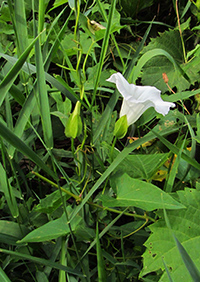Table of Contents
Johan Kunzle wrote about the hedge bindweed plant: “We have to give Thanks to God since He literally put at our feet such a precious remedy as this.”

Healing Properties and Indications
All parts of this plant, especially the root, contain tannin and a resinous glycoside (convolvuline), similar in chemical composition and properties to that obtained from the jalap root. It has purgative, cholagogue, and choleretic properties.
- As a laxative, it acts energetically but does not produce irritation or vomiting. It is recommended for acute constipation. This plant can be administered to children.
- As a cholagogue, it eases the evacuation of the bile and is recommended for liver inflammation or congestion and in disorders relative to gall bladder emptying.

Field Bindweed
Field bindweed (Convolvulus arvensis L.) is smaller (as its name says) than greater bindweed; however, it has practically the same properties.
Palo de Rosa
In the Canary Islands, two endemic species of the convolvulus genus are locally called Palo de rosa (Convolvulus floridus L.). The essence obtained from their roots has practically the same medicinal properties as those of the hedge bindweed plant.
- Promotes healthy elimination of natural toxins*
- 10:1
- 120 Capsules
- 500 mg per capsule, 1000 mg serving
Hedge Bindweed Plant Scientific Facts

- Scientific synonyms: Convolvulus sepium L.
- Other names: Devil’s vine, great bindweed, hedge lily, Lady’s night-cap, rutland beauty, trailing bindweed, lesser bindweed.
- French: Liseron.
- Spanish: Correhuela mayor.
- Environment: Very common in bushes and boundaries all over Europe and America.
- Description: This is a vigorous climbing plant of the Convolvulusaceae family whose stems grow to 2.5 m long. It has heart-shaped leaves, and its flowers are large and pure white.
- Parts of the plant used medicinally: The root and the leaves.
How to use Hedge Bindweed
- Infusion with a spoonful of ground root or leaves per cup of water. Drink up to three cups daily, sweetened with honey.
- Powder. The usual dose is 1-3 g, distributed into three daily intakes.
Frequently Asked Question
What are the primary health benefits of the hedge bindweed plant?
Hedge bindweed (Calystegia sepium) is recognized for its health-promoting properties, mainly attributed to its abundant nutrients. The product includes vitamins, minerals, and antioxidants that enhance general health.
Does the hedge bindweed plant have any anti-inflammatory properties?
Yes, studies suggest that hedge bindweed possesses anti-inflammatory properties due to compounds like flavonoids and alkaloids present in its composition. These properties may help reduce inflammation in the body.
Can hedge bindweed aid in digestion?
Yes, hedge bindweed has been traditionally used to support digestive health. It contains dietary fiber, which aids digestion by promoting regular bowel movements and preventing constipation.
Is hedge bindweed beneficial for skin health?
Some studies suggest that it may have potential benefits for skin health. Its antioxidant qualities shield the skin from oxidative stress and perhaps enhance health.
Does hedge bindweed have any potential effects on blood sugar levels?
Research indicates that certain compounds in this plant may have hypoglycemic effects, potentially helping regulate blood sugar levels. However, more studies are needed to understand its full impact on blood glucose.
Can hedge bindweed be used to support weight management?
The plant can not directly cause weight reduction. Still, its abundance of fiber can help increase satiety and assist in weight control by enhancing a well-functioning metabolism and digestion.
Are there any known benefits of hedge bindweed for respiratory health?
Some cultures have traditionally used it to alleviate respiratory issues such as coughs and colds. Its expectorant qualities can help loosen mucus and relieve congestion.
Does hedge bindweed contain any vitamins or minerals?
The plant is a source of vitamins and minerals, including vitamins C and A, potassium, calcium, and magnesium. These nutrients are essential for sustaining excellent health.
Is the hedge bindweed plant safe for consumption?
The plant is healthy in modest doses as part of a balanced diet. Still, excessive ingestion can have severe effects on some people. Consult a healthcare practitioner before utilizing any herbal treatment for therapeutic purposes.
Are there any known contraindications or side effects associated with the hedge bindweed plant?
Consuming hedge bindweed may cause allergic responses or intestinal distress in some people. Pregnant or breastfeeding women, those with specific medical conditions, or those taking drugs should be cautious and seek guidance from a healthcare expert before utilizing it for therapeutic purposes.
DISCLAIMER: All content on this website is presented solely for educational and informational objectives. Do not rely on the information provided as a replacement for advice, diagnosis, or treatment from a qualified medical expert. If you are pregnant, nursing, or have any preexisting medical concerns, talk to your doctor before using any herbal or natural medicines.
REFERENCES
- George D. Pamplona-Roger, M.D. “Encyclopedia of Medicinal Plants.” George D. Pamplona-Roger, M.D. Encyclopedia of Medicinal Plants. Ed. Francesc X. Gelabert. vols. 2 San Fernando de Henares: Editorial Safeliz, 2000. 491. Print.[hedge bindweed plant]
- USDA Plants Database: https://plants.usda.gov
- PubMed: https://pubmed.ncbi.nlm.nih.gov
- Google Scholar: https://scholar.google.com
- WebMD: https://www.webmd.com
- National Center for Complementary and Integrative Health (NCCIH): https://nccih.nih.gov
- Botanical Society of Britain & Ireland (BSBI): https://bsbi.org
- Royal Botanic Gardens, Kew: https://www.kew.org
Last update on 2024-07-21 / Affiliate links / Images from Amazon Product Advertising API

